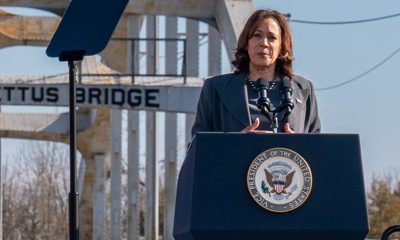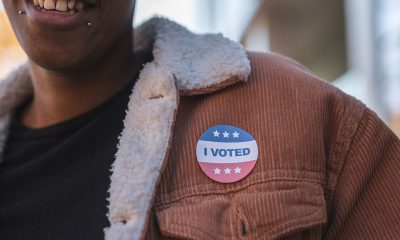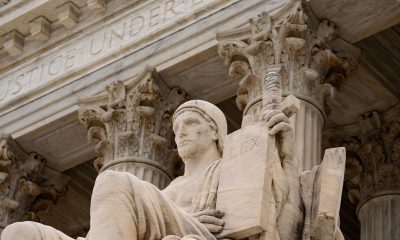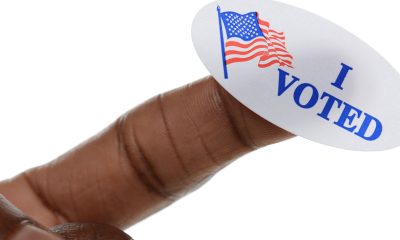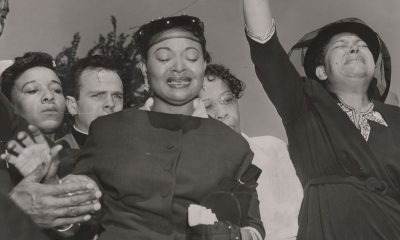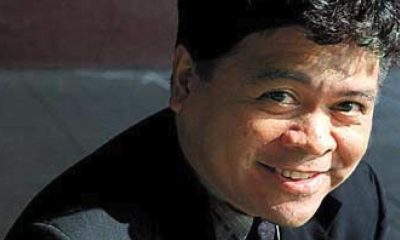Politics
Blacks Still Underrepresented at All Levels of Politics

Joint Center for Political and Economic Studies President Spencer Overton says there is a heated debate over how much progress we have made over the past 50 years. (Courtesy Photo)
By George E. Curry
NNPA Editor-in-Chief
WASHINGTON (NNPA) – Although Blacks have made tremendous improvement in holding elected office since passage of the 1965 Voting Rights Act, they remain underrepresented at the federal, state and local levels, according to a report scheduled to be released Tuesday by the Joint Center for Political and Economic Studies.
“Based on the most recent data, African Americans are 12.5% of the citizen voting age population, but they make up a smaller share of the U.S. House (10%), state legislatures (8.5%), city councils (5.7%), and the U.S. Senate (2%),” the report said.
The 38-page report titled, “50 Years of The Voting Rights Act: The State of Race in Politics,” was produced for the center by four prominent political scientists: Khalilah Brown-Dean, Zoltan Hajnal, Christina Rivers and Ismail White.
Joint Center President Spencer Overton said in a message introducing the report, that there is a heated debate over: How much progress have we made since 1965? How much more work is there to do?
He said, “These are contested questions, subject to ideology and opinion. A study published in Perspectives on Psychological Science, for example, shows that on average whites and African Americans differ on the amount of racial progress we have made, with whites now believing anti-white bias is more prevalent than anti-black bias. We have elected an African American president, but studies have shown that some government officials are less likely to respond to inquiries from citizens with seemingly black or Latino names. The questions are also at the core of many ongoing debates about voting rights in the U.S. Supreme Court and Congress, as well as in many states, counties, and municipalities.”
What is not contested is that the Voting Rights Act of 1965 changed the political landscape for African Americans, with the number of Black elected officials leaping from fewer than 1,000 in 1965 to now more than 10,000.
The change was particularly dramatic in the South, where 55 percent of African Americans live.
“Since the 1870s, white elected officials in many parts of the South had used violence, literacy tests, interpretation tests, poll taxes, and other devices to exclude African Americans,” the report recounted. “The Justice Department filed 71 voting rights lawsuits in the Deep South before 1965, but cases were typically complex, time-consuming, and expensive. When a court struck down one type of discriminatory device, local officials simply erected a different device that effectively excluded most African Americans.”
Selma, Ala. and surrounding Dallas County was typical. Deploying rigged tests about the U.S. Constitution and a requirement that voters be in “good character,” as defined by White registrars, a White minority was able to suppress the Black majority.
In 1965, more than half of Dallas County was Black. Of the county’s 15,000 voting-age Blacks, only 156 were registered to vote. By contrast, two-thirds of voting-age Whites were registered in the county. Throughout Alabama, only 19.4 percent of African Americans were registered. In neighboring Mississippi, just 6.4 percent of Blacks were registered.
As part of a massive voter registration campaign in 1965, the Southern Christian Leadership Conference (SCLC), the Student Nonviolent Coordinating Committee (SNCC) and local residents launched a Selma-to-Montgomery March to dramatize the lack of access to the ballot box.
On April 7, in what became known as “Bloody Sunday,” peaceful marchers in Selma were savagely beaten by Alabama State Troopers and local policemen as they attempted to walk across the Edmund Pettus Bridge to begin the 54-mile journey to Montgomery, the state capital.
The merciless beating of children, the elderly and adults was beamed in homes throughout the nation and provided the momentum for President Lyndon B. Johnson to sign the Voting Rights Act into law four months later.
“Only in the wake of the Voting Rights Act did black voter registration in the South begin to approach that of whites. Five years after the passage of the Act, the racial gap in voter registration in the former Confederate states had closed to single digits. By the start of the 1970s, the black/white registration gap across the Southern states was little more than 8 percentage points,” the report stated.
“In Louisiana, the gap between black and white voter registration rates decreased by nearly 30 percentage points from 1960 to the end of 1970s, and it continued to decrease over the next three decades. By 2010, black registration rates in the state of Louisiana and many of the other former Confederate states had exceeded white registration rates for the first time since Reconstruction. The Voting Rights Act had delivered a Second Reconstruction.”
In fact, in four of the 12 presidential elections since 1965, Black Southerners turned out at the polls at a higher rate than their White counterparts. Nationally, Black turnout exceeded White turnout in the 2012 presidential election and possibly in 2008, according to the report.
Activists credit much of that progress to the Voting Rights Act requirement that jurisdictions that previously discriminated against Blacks had to pre-clear voting changes in advance with federal authorities.
However, the Supreme Court’s decision in Shelby took away that tool and there is a measure pending in Congress that would reverse some of the damage. A House bill sponsored by “Bloody Sunday” veteran John Lewis (D-Ga.) and Jim Sensenbrenner (R-Wisconsin) would update the act.
“The proposed legislation would apply preclearance to jurisdictions with a record of voting rights violations within the previous 15 years, would make it easier for courts to block discriminatory rules before they are used in elections and harm voters, and would require disclosure of voting changes nationwide,” the report stated.
Efforts to expand the Black vote is also under attack in others quarters as well. The Joint Center report cited moves to purge voters, requiring proof of citizenship, requiring voter ID, felony disenfranchisement and restricting voting registration drives.
The report also addressed the elephant in the room – race.
“In urban local elections, race is a more decisive factor than income, education …religion, sexuality, age, gender, and political ideology. The 38-point racial gap exceeds even the 33 point gap between Democratic and Republican voters,” the study said.
According to the report, African Americans “were the least advantaged group in America in terms of policy outcomes.”
Not all of the problems were external. The issue of low Black voter turnout, especially in local elections, is a major challenge that warrants further study, the report said.
It noted, “ …In 2014, when there was great unrest over a police officer’s killing of Michael Brown, African Americans made up 67% of residents of Ferguson, Missouri. In 2012, a solid 100% of Ferguson precincts went for President Obama, but during Ferguson’s municipal off-cycle elections voters selected Ferguson’s Republican mayor and six city council members, all of whom except one were white.”
The report shatters the notion that we’re living in a post-racial society.
“Despite discussions about the declining significance of race, over the past few decades, racial divides along partisan lines have actually grown. African Americans have increasingly favored Democrats, and recently Latinos and Asian Americans have become more loyal to the Democratic Party as well. The shift to the left has been particularly pronounced for Asian Americans,” it said.
“On the other side, whites have moved slowly and unevenly – but inexorably – to the Republican Party. Fifty years ago, the Democratic Party dominated the white vote. Today, nationwide, whites are more apt to favor the Republican Party.”
It concluded, “Division is a normal and healthy part of democracy, but when a core dividing line in a nation becomes so closely aligned with race and ethnicity, larger concerns about inequality, conflict, and discrimination emerge.”
###
Activism
Oakland Post: Week of April 24 – 30, 2024
The printed Weekly Edition of the Oakland Post: Week of April 24 – 30, 2024

To enlarge your view of this issue, use the slider, magnifying glass icon or full page icon in the lower right corner of the browser window. ![]()
Bay Area
MAYOR BREED ANNOUNCES $53 MILLION FEDERAL GRANT FOR SAN FRANCISCO’S HOMELESS PROGRAMS
San Francisco, CA – Mayor London N. Breed today announced that the U.S. Department of Housing and Urban Development (HUD) has awarded the city a $53.7 million grant to support efforts to renew and expand critical services and housing for people experiencing homelessness in San Francisco.
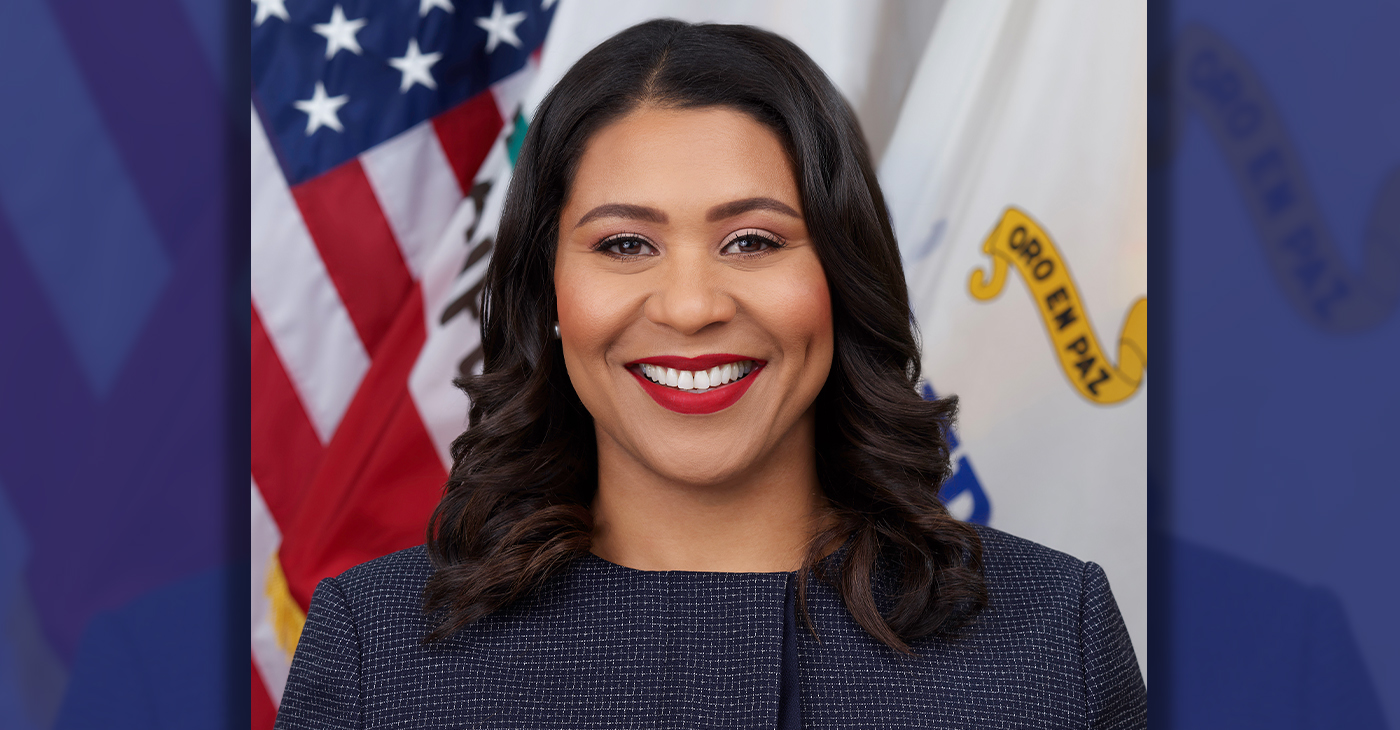
FOR IMMEDIATE RELEASE:
Wednesday, January 31, 2024
Contact: Mayor’s Office of Communications, mayorspressoffice@sfgov.org
***PRESS RELEASE***
MAYOR BREED ANNOUNCES $53 MILLION FEDERAL GRANT FOR SAN FRANCISCO’S HOMELESS PROGRAMS
HUD’s Continuum of Care grant will support the City’s range of critical services and programs, including permanent supportive housing, rapid re-housing, and improved access to housing for survivors of domestic violence
San Francisco, CA – Mayor London N. Breed today announced that the U.S. Department of Housing and Urban Development (HUD) has awarded the city a $53.7 million grant to support efforts to renew and expand critical services and housing for people experiencing homelessness in San Francisco.
HUD’s Continuum of Care (CoC) program is designed to support local programs with the goal of ending homelessness for individuals, families, and Transitional Age Youth.
This funding supports the city’s ongoing efforts that have helped more than 15,000 people exit homelessness since 2018 through City programs including direct housing placements and relocation assistance. During that time San Francisco has also increased housing slots by 50%. San Francisco has the most permanent supportive housing of any county in the Bay Area, and the second most slots per capita than any city in the country.
“In San Francisco, we have worked aggressively to increase housing, shelter, and services for people experiencing homelessness, and we are building on these efforts every day,” said Mayor London Breed. “Every day our encampment outreach workers are going out to bring people indoors and our City workers are connecting people to housing and shelter. This support from the federal government is critical and will allow us to serve people in need and address encampments in our neighborhoods.”
The funding towards supporting the renewal projects in San Francisco include financial support for a mix of permanent supportive housing, rapid re-housing, and transitional housing projects. In addition, the CoC award will support Coordinated Entry projects to centralize the City’s various efforts to address homelessness. This includes $2.1 million in funding for the Coordinated Entry system to improve access to housing for youth and survivors of domestic violence.
“This is a good day for San Francisco,” said Shireen McSpadden, executive director of the Department of Homelessness and Supportive Housing. “HUD’s Continuum of Care funding provides vital resources to a diversity of programs and projects that have helped people to stabilize in our community. This funding is a testament to our work and the work of our nonprofit partners.”
The 2024 Continuum of Care Renewal Awards Include:
- $42.2 million for 29 renewal PSH projects that serve chronically homeless, veterans, and youth
- $318,000 for one new PSH project, which will provide 98 affordable homes for low-income seniors in the Richmond District
- $445,00 for one Transitional Housing (TH) project serving youth
- $6.4 million dedicated to four Rapid Rehousing (RRH) projects that serve families, youth, and survivors of domestic violence
- $750,00 for two Homeless Management Information System (HMIS) projects
- $2.1 million for three Coordinated Entry projects that serve families, youth, chronically homeless, and survivors of domestic violence
In addition, the 2023 CoC Planning Grant, now increased to $1,500,000 from $1,250,000, was also approved. Planning grants are submitted non-competitively and may be used to carry out the duties of operating a CoC, such as system evaluation and planning, monitoring, project and system performance improvement, providing trainings, partner collaborations, and conducting the PIT Count.
“We are very appreciative of HUD’s support in fulfilling our funding request for these critically important projects for San Francisco that help so many people trying to exit homelessness,” said Del Seymour, co-chair of the Local Homeless Coordinating Board. “This funding will make a real difference to people seeking services and support in their journey out of homelessness.”
In comparison to last year’s competition, this represents a $770,000 increase in funding, due to a new PSH project that was funded, an increase in some unit type Fair Market Rents (FMRs) and the larger CoC Planning Grant. In a year where more projects had to compete nationally against other communities, this represents a significant increase.
Nationally, HUD awarded nearly $3.16 billion for over 7,000 local homeless housing and service programs including new projects and renewals across the United States.
Activism
Oakland Post: Week of April 17 – 23, 2024
The printed Weekly Edition of the Oakland Post: Week of April 17 – 23, 2024

To enlarge your view of this issue, use the slider, magnifying glass icon or full page icon in the lower right corner of the browser window. ![]()
-

 Activism4 weeks ago
Activism4 weeks agoOakland Post: Week of March 27 – April 2, 2024
-

 #NNPA BlackPress4 weeks ago
#NNPA BlackPress4 weeks agoBeloved Actor and Activist Louis Cameron Gossett Jr. Dies at 87
-

 Community1 week ago
Community1 week agoFinancial Assistance Bill for Descendants of Enslaved Persons to Help Them Purchase, Own, or Maintain a Home
-

 Activism3 weeks ago
Activism3 weeks agoOakland Post: Week of April 3 – 6, 2024
-

 Business2 weeks ago
Business2 weeks agoV.P. Kamala Harris: Americans With Criminal Records Will Soon Be Eligible for SBA Loans
-

 Activism2 weeks ago
Activism2 weeks agoOakland Post: Week of April 10 – 16, 2024
-

 Community2 weeks ago
Community2 weeks agoAG Bonta Says Oakland School Leaders Should Comply with State Laws to Avoid ‘Disparate Harm’ When Closing or Merging Schools
-

 Community7 days ago
Community7 days agoOakland WNBA Player to be Inducted Into Hall of Fame


